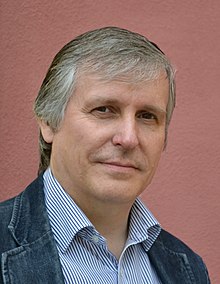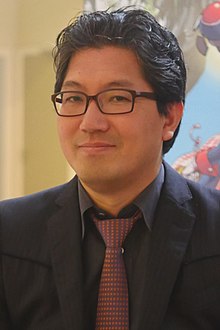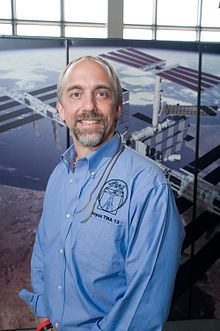Portal:Video games
The Video Games Portal

A video game or computer game is an electronic game that involves interaction with a user interface or input device (such as a joystick, controller, keyboard, or motion sensing device) to generate visual feedback from a display device, most commonly shown in a video format on a television set, computer monitor, flat-panel display or touchscreen on handheld devices, or a virtual reality headset. Most modern video games are audiovisual, with audio complement delivered through speakers or headphones, and sometimes also with other types of sensory feedback (e.g., haptic technology that provides tactile sensations). Some video games also allow microphone and webcam inputs for in-game chatting and livestreaming.
Video games are typically categorized according to their hardware platform, which traditionally includes arcade video games, console games, and computer games (which includes LAN games, online games, and browser games). More recently, the video game industry has expanded onto mobile gaming through mobile devices (such as smartphones and tablet computers), virtual and augmented reality systems, and remote cloud gaming. Video games are also classified into a wide range of genres based on their style of gameplay and target audience. (Full article...)
Featured articles –

A team of approximately 1,000 people developed Grand Theft Auto V over several years. Rockstar Games released the action-adventure game in September 2013 for PlayStation 3 and Xbox 360, in November 2014 for PlayStation 4 and Xbox One, in April 2015 for Windows, and in March 2022 for PlayStation 5 and Xbox Series X/S. The first main Grand Theft Auto series entry since Grand Theft Auto IV, its development was led by Rockstar North's core 360-person team, who collaborated with several other international Rockstar studios. The team considered the game a spiritual successor to many of their previous projects like Red Dead Redemption and Max Payne 3. After its unexpected announcement in 2011, the game was fervently promoted with press showings, cinematic trailers, viral marketing strategies and special editions. Its release date, though subject to several delays, was widely anticipated.
The open world setting, modelled on Los Angeles and other areas of Southern California, constituted much of the development effort. Key team members conducted field trips around Southern California to gather research and footage, and Google Maps projections of Los Angeles were used to help design the city's road networks. The proprietary Rockstar Advanced Game Engine (RAGE) was overhauled to increase its draw distance rendering capabilities. For the first time in the series, players control three protagonists throughout the single-player mode. The team found the multiple-protagonist design a fundamental change to the story and gameplay devices. They refined the shooting and driving mechanics and tightened the narrative's pacing and scope.
The actors selected to portray the protagonists invested much time and research into character development. Motion capture was used to record the characters' facial and body movements. Like its predecessors, the game features an in-game radio that plays a selection of licensed music tracks. An original score was composed over several years by a team of five music producers. They worked in close collaboration, sampling and incorporating different influences into each other's ideas. The game's 2014 re-release added a first-person view option along with the traditional third-person view. To accommodate first-person, the game received a major visual and technical upgrade, as well as new gameplay features like a replay editor that lets players create gameplay videos. (Full article...)
Dungeon Siege was the first title by Gas Powered Games, which was founded in May 1998 by Chris Taylor, then known for the 1997 real-time strategy game Total Annihilation. Joined by several of his coworkers from Cavedog Entertainment, Taylor wanted to create a different type of game, and after trying several concepts they decided to make an action role-playing game as their first title. Taylor also served as one of the designers for the game, joined by Jacob McMahon as the other lead designer and producer and Neal Hallford as the lead story and dialogue writer. The music was composed by Jeremy Soule, who had also worked on Total Annihilation. Gas Powered Games concentrated on making a role-playing game that was stripped of the typical genre elements they found slow or frustrating, to keep the player focused on the action. Development took over four years, though it was initially planned to take only two; completing the game within even four years required the team to work 12- to 14-hour days and weekends for most of the time.
The game was highly rated by critics upon release; it is listed by review aggregator Metacritic as the third-highest rated computer role-playing game of 2002. Critics praised the graphics and seamless world, as well as the fun and accessible gameplay, but were dismissive of the plot. Dungeon Siege sold over 1.7 million copies, and was nominated for the Computer Role-Playing Game of the Year award by the Academy of Interactive Arts & Sciences. Gas Powered Games emphasized creating and releasing tools for players to use in making mods for the game during development, which resulted in an active modding community after release. An expansion pack, Dungeon Siege: Legends of Aranna, was released in 2003, and a further series of games was developed in the franchise, consisting of Dungeon Siege II (2005) and its own expansion Dungeon Siege II: Broken World (2006), a spinoff PlayStation Portable game titled Dungeon Siege: Throne of Agony (2006), and a third main title, Dungeon Siege III (2011). A trilogy of movies, with the first loosely inspired by the plot of Dungeon Siege, were released as In the Name of the King: A Dungeon Siege Tale (2007, theaters), In the Name of the King 2: Two Worlds (2011, home video), and In the Name of the King 3: The Last Mission (2014, home video). (Full article...)
Melee includes all playable characters from the first game and also adds characters from additional franchises such as Fire Emblem, of which no games had been released outside Japan at the time, in addition to new stages and gameplay modes. Like other games in the Smash Bros. series, Melee's gameplay system offers an unorthodox approach to the fighting game genre, with a counter that measures damage with increasing percentages, representing the knockback the character will experience, rather than the depleting health bar seen in most fighting games.
Melee was first released in Japan in November 2001, in the Americas in December 2001, and in Europe and Australia in May 2002. The game received widespread acclaim from critics, earning praise for its visuals, simple controls, gameplay, and orchestrated soundtrack, as well as several awards and acknowledgments from various publications; it is now considered one of the greatest video games ever made. It achieved strong sales upon its release, becoming the GameCube's best-selling title, with over seven million copies sold by 2008. Considered one of the most competitively viable Smash Bros. games due to its fast-paced, aggressive gameplay and continuously developing metagame, Melee has been featured in many competitive gaming tournaments, boasting a dedicated grassroots fan community which has kept its competitive scene alive well beyond the game's original lifespan. It was followed by Super Smash Bros. Brawl for the Wii in 2008. (Full article...)

Sega Corporation is a Japanese video game company and subsidiary of Sega Sammy Holdings headquartered in Tokyo. It produces several multi-million-selling game franchises for arcades and consoles, including Sonic the Hedgehog, Angry Birds, Phantasy Star, Puyo Puyo, Super Monkey Ball, Total War, Virtua Fighter, Megami Tensei, Sakura Wars, Persona, and Yakuza. From 1983 until 2001, Sega also developed its own consoles.
Sega was founded by Martin Bromley and Richard Stewart in Hawaii as Nihon Goraku Bussan on June 3, 1960. Shortly after, it acquired the assets of its predecessor, Service Games of Japan. In 1965, it became known as Sega Enterprises, Ltd., after acquiring Rosen Enterprises, an importer of coin-operated games. Sega developed its first coin-operated game, Periscope, in 1966. Sega was sold to Gulf and Western Industries in 1969. Following a downturn in the arcade business in the early 1980s, Sega began to develop video game consoles, starting with the SG-1000 and Master System, but struggled against competitors such as the Nintendo Entertainment System. In 1984, Sega executives David Rosen and Hayao Nakayama led a management buyout, with backing from CSK Corporation.
In 1988, Sega released the Mega Drive, or the Genesis in North America. The Mega Drive struggled against competition in Japan, but the Genesis found success overseas after the release of Sonic the Hedgehog in 1991 and briefly outsold its main competitor, the Super Nintendo Entertainment System, in the US. In 2001, after several commercial failures such as the 32X, Saturn, and Dreamcast, Sega stopped manufacturing consoles to become a third-party developer and publisher, and was acquired by Sammy Corporation in 2004. Sega Holdings Co., Ltd. was established in 2015; Sega Corporation was renamed to Sega Games Co., Ltd., and its arcade division was split into Sega Interactive. In 2020, Sega Games and Sega Interactive merged to become Sega Corporation. (Full article...)
Did you know... -
- ... that players of the simulation video game Overcrowd: A Commute 'Em Up need to manage everything from the construction of train stations to dumping trash cans?
- ... that the game designer of the video game Hades said that the characters were attractive "because Jen Zee"?
- ... that the 1987 video game Oriental Hero was panned as "so incredibly bad it's almost worth a look"?
- ... that match-three video games such as Candy Crush Saga are often considered to be Bejeweled clones?
- ... that Paul Dini was a writer for both the animated television series Batman: The Animated Series and the video game series Batman: Arkham?
- ... that classified documents of the United States were partially leaked onto a Discord server for the video game Minecraft?
- ... that the contrabass trombone has experienced a revival in film music and video game soundtracks?
- ... that the 1979 video game Superman was one of the first console games with a pause feature?
- ... that the 2014 text adventure The Uncle Who Works for Nintendo is inspired by a source cited by children for spreading video game rumors?
- ... that Cybermania '94 was the first televised video game awards show?
- ... that the world's largest video game studio is headquartered in a former textile factory?
- ... that when Kaz Ayabe pitched his video game Boku no Natsuyasumi to Sony, he said that illustrator Mineko Ueda was interested in the project even though they had never actually met?
Selected biography –
Selected image -

Recent video game-related events
- January 16, 2025 –
- Nintendo officially reveals the Nintendo Switch 2 video game console, the successor to the Nintendo Switch. (Nintendo)
- September 12, 2024 – 2023–2024 video game industry layoffs
- Microsoft announces that it will lay off 650 Microsoft Gaming employees as part of cuts to its workforce. (Variety)
- August 15, 2024 –
- American video game magazine Game Informer discontinues publication after 33 years. The magazine's website is also shut down. (BBC News)
Topics
Categories
Things you can do
In other Wikimedia projects
The following Wikimedia Foundation sister projects provide more on this subject:
-
Commons
Free media repository -
Wikibooks
Free textbooks and manuals -
Wikidata
Free knowledge base -
Wikinews
Free-content news -
Wikiquote
Collection of quotations -
Wikisource
Free-content library -
Wikiversity
Free learning tools -
Wiktionary
Dictionary and thesaurus














































